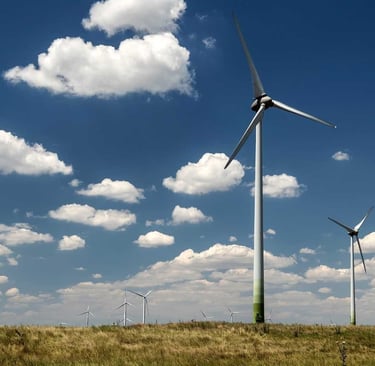Romania: Regional Cooperation on Green Energy
Romania’s ambitious green energy initiatives signal a transformative era for the nation and the broader region. How will its proactive investments and partnerships reshape Eastern Europe’s energy landscape and foster economic growth?
ROMANIA
Taissiya Sheguy
11/13/20243 min read


Romania expects to complete 10,000 megawatts of solar and wind energy projects in the next three to five years. Romanian Energy Minister Sebastian-Ion Burduja announced this during the 9th Ministerial Meeting, held in accordance with the Strategic Partnership Agreement for the Development and Transmission of Green Energy between the governments of Azerbaijan, Georgia, Romania, and Hungary.
Romania has signed a contract for the construction of two additional large nuclear reactors in the Black Sea region with a combined capacity of 1,400 megawatts. Legislation has also been developed to facilitate the use of wind energy on the Black Sea shelf. According to the World Bank, the region’s potential for wind energy is an impressive 75 gigawatts, though practical development estimates suggest a capacity of between 3 and 7 gigawatts by 2032. Minister Burduja highlighted a pressing challenge: southeastern Romania’s current energy grid is already operating at its limit. “Without this project, we will not be able to transmit the energy produced by the new reactors, as well as by future offshore and onshore capacities,” he stated.
The country’s commitment to renewable energy is further demonstrated by its plan to finance and complete 10,000 megawatts of solar and wind energy projects over the next three to five years. Minister Burduja also emphasised that this expansion creates additional demands on the grid in terms of balancing. He underscored the utility of the High-Voltage Direct Current (HVDC) connection as a critical tool for dispatchers to balance the network, not only within Romania but also for Hungary, Georgia, and Azerbaijan. “We strongly support this project and are eager to move forward,” he added.
On 17 December 2022, Azerbaijan, Georgia, Romania, and Hungary signed a strategic partnership agreement in Bucharest to construct the Black Sea Energy submarine power cable with a capacity of 1 gigawatt. By June 2023, Bulgaria announced its intention to join the initiative. In May 2024, energy operators from the four countries signed a memorandum establishing a joint venture within the Black Sea Energy project. On 13 August 2024, Georgian authorities revealed that the Italian consulting firm CESI had completed a feasibility study on the submarine cable. The study concluded that the project is both economically promising and technically feasible, with construction expected to take 3-4 years. The European Commission plans to allocate €2.3 billion to finance this initiative.
Romania’s strategic position in Eastern Europe has been reinforced by its commitment to green energy, enhancing its energy security and reducing dependence on Russian imports. A key example is the construction of two CANDU nuclear reactors, funded by $7.25 billion in export credits from the U.S., Canada, and Italy. Additionally, the establishment of the Green Energy Corridor Power Company, a joint venture with Azerbaijan, Georgia, and Hungary, aims to construct a 1,100-kilometre subsea interconnector across the Black Sea. This infrastructure will link planned Azeri wind farms to Europe, demonstrating Romania’s pivotal role in diversifying energy resources away from Russia amid ongoing geopolitical tensions.
The European Commission’s approval of Romania’s modified Recovery and Resilience Plan, valued at €28.5 billion, further bolsters the nation’s green energy ambitions. This plan includes a REPowerEU chapter and private sector investments, such as OMV Petrom’s €750 million project to produce sustainable aviation fuels, renewable diesel, and green hydrogen. Such initiatives aim to accelerate green energy production while addressing the need for economic reforms.
In addition to large-scale projects, Romania is advancing smaller yet impactful ventures. The development of a 15-megawatt biomethane production plant by Black Sea Oil & Gas and DN Agrar is expected to reduce carbon emissions and create employment opportunities. However, the ongoing phase-out of coal has resulted in job losses, necessitating retraining programs for affected workers. Energy-intensive industries face challenges due to European Union green policies. To mitigate these difficulties, Romania received approval for a RON 2.9 billion grant scheme aimed at reducing electricity taxation for large energy consumers.
Romania’s joint venture with Azerbaijan, Georgia, and Hungary represents a significant step towards a sustainable energy future. This initiative is expected to yield substantial economic benefits, promote environmental sustainability, and strengthen regional cooperation in the energy sector. The proactive approach to renewable energy positions Romania as a key player in Eastern Europe’s energy transition, attracting foreign investments and fostering innovation in sectors like construction, energy, and technology.
Economic impacts from these developments are substantial. Increased green energy production and transmission infrastructure will reduce reliance on imports, strengthening Romania’s trade balance. The construction of advanced energy facilities and interconnectors will create thousands of jobs, from engineering to operations. International businesses specialising in renewable energy, grid modernisation, and sustainable fuels will find ample opportunities in Romania’s expanding green market. Furthermore, reduced energy costs and improved energy security will make Romania a more attractive destination for industrial investments. Overall, these initiatives not only align with global sustainability goals but also ensure economic resilience and growth for Romania in a rapidly changing energy landscape.


